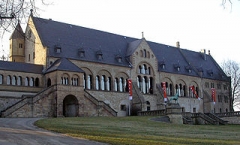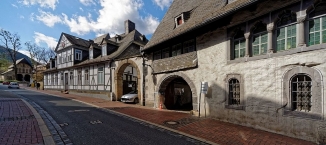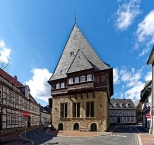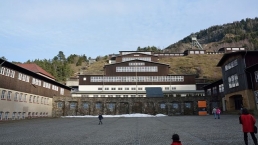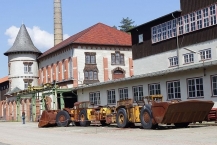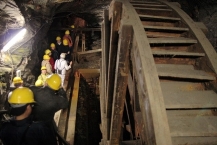Cycle Route Harz Cycle Loop
Actions
![]()
Please wait - map data are loading
Added on 25 Apr 2012,
last edited by biroto-Redaktion on 16 Nov 2020
Actions
Cycle route metrics
Total distance in km
318
Information about rights to the gps-track data | |
|---|---|
Rights owner | OpenStreetMap and Contributors + biroto-Redaktion (biroto.eu) |
Rights characteristic / license | Contains information from OpenStreetMap, which is made available here under the Open Database License(ODbL) |
Link to the description of the license | |
GPX file taken from | |
GPX file uploaded | by biroto-Redaktion on 16 Nov 2020
|
Track points in total
5.550
Track points per km (avg)
17
Start/endpoint
Start location
Goslar, Niedersachsen, DE (265 m NHN)
End location
Goslar, Niedersachsen, DE (265 m NHN)
Signposting
|
Travel reports about cycle tours
09 Jun 2012
91 km
A stage of the tour »Spandau - R1 - Münster« of user ThimbleU
01 Oct 2021
89 km
A stage of the tour »Forchheim - Halle - Brunswick« of user ThimbleU
Beds4Cyclists, worth visiting and infrastructure
Name and address
Latitude / Longitude
Phone
Fax
Mobile
Type of accommodation
Rating for cyclists
Route km
Dist. to route
Elevation
0 km
0,0 km
272 m
1 km
0,1 km
263 m
Information about copyright | |
|---|---|
Rights owner | |
Rights characteristic / license | by-sa: CREATIVE COMMONS Attribution-ShareAlike |
Link to the description of the license | |
Image taken over from | |
Image has been uploaded | by biroto-Redaktion on 06 Apr 2012
|
Information about copyright | |
|---|---|
Rights owner | |
Rights characteristic / license | by-sa: CREATIVE COMMONS Attribution-ShareAlike |
Link to the description of the license | |
Image taken over from | https://commons.wikimedia.org/wiki/File:Das_ehemalige_Hospital_Großes_Heiliges_Kreuz_in_Goslar.jpg |
Image has been uploaded | by biroto-Redaktion on 06 Oct 2016
|
Information about copyright | |
|---|---|
Rights owner | https://commons.wikimedia.org/w/index.php?title=User:Valeri_Koshelev |
Rights characteristic / license | by-sa: CREATIVE COMMONS Attribution-ShareAlike |
Link to the description of the license | |
Image taken over from | https://commons.wikimedia.org/wiki/File:Goslar_Marktplatz.jpg |
Image has been uploaded | by biroto-Redaktion on 06 Oct 2016
|
Information about copyright | |
|---|---|
Rights owner | |
Rights characteristic / license | by-sa: CREATIVE COMMONS Attribution-ShareAlike |
Link to the description of the license | |
Image taken over from | https://commons.wikimedia.org/wiki/File:Die_Altstadt_Goslar,_das_Bäckergildehaus.jpg |
Image has been uploaded | by biroto-Redaktion on 06 Oct 2016
|
Goslar is a medieval town in Lower Saxony and serves as a regional hub to the wider Harz area. It lies at the foot of the Harz Mountains (highest elevation 3,744 feet). Goslar is situated some 150 Miles West of Berlin. The nearest cities are Brunswick, Hanover, and Magdeburg. Goslar is much older than Berlin and worth a visit. If you are interested in history, outdoor pursuits (especially hiking), tranquility and nature, then Goslar is the right spot for you.
Understand
Goslar was founded in 922 AD, although it is widely assumed that it has been settled since pre-Roman times. The town is famed for its magnificent gates and ramparts, the medieval Imperial Palace, Romanesque churches, its half timbered guild houses, the ancient Rammelsberg ore mine. and its witches, the last of which was burned at the stake in 1657 AD. In medieval times the city was a major producer of armouries and coins—the raw ores for their manufacture came from the Rammelsberg mine just outside the city's walls.
History
What, Ram + Goat = Goslar? Not quite.! According to legend, Ramm, a knight to Henry's son Otto the Great, tied his horse to a tree, half way up the Rammelsberg, to continue hunting in the undergrowth. In anticipation of the return of its owner, the horse scraped with its hoof in the ground laying open a ledge of silver so rich that it took over a millennium to mine. Hence the mountain and mine were called the Rammelsberg, after Otto's knight Ramm. As the wife of knight Ramm was called Gosa, they named the town Goslar in her honor.
Emperors, Dukes, and Townsfolk Essentially Goslar was a Free Imperial City, which was under direct control of the Emperor and there were no regional feudal overlords, who were in charge of the city until the end of the Thirty's Year War. Thus the citizens were largely left to their own devices, since the emperors had mostly better things to do than to sit in their Imperial Palace at Goslar. There were several other imperial palaces throughout the Holy Roman Empire, where the emperors held court. The only problem for the city's craftsmen was that their Free Imperial City ended right behind the city's walls. Unfortunately for them, the mine they depended upon, for the delivery of the ores, was immediately outside these very city walls. So they had to lease the rights to the mine from even such regional feudal overlords, the Dukes of Brunswick, who would have fancied it, if the city was theirs. This inevitably let to regular skirmishes between the Dukes and their men on the one side, and the burghers on the other side, which were not resolved until the end of the Thirty's Year War in 1642 AD with the Goslar Accord.
Goethe's Goslar Gothic Ghosts. With the onset of the Reformation in 1517 AD Goslar has escaped the interest of the emperor, and its riches declined so that Goethe, Germany's national polymath, writes in 1777 during his visit to Goslar: "Imperial City, which rots 'inside' and 'with' its privileges!"
UNESCO World Heritage Status
This might be a reason why the Rammelsberg Mine and Town have been so uniquely preserved that they hold UNESCO World Heritage Status.
See
Castles/Buildings of Interest
- ⊙Kaiserpfalz Imperial Palace. – built between 1040 and 1050. For more than 200 years German and European history was made here. Open: April - Oct: 10AM - 5PM, Nov - March: 10AM - 4PM, closed during special events. Admission: Adults € 7.50, Children/Youth € 4.50. Kaiserbleek 6, ☎ +49 5321 3119693.
- ⊙Zwinger, Thomasstraße 2, ☎ +49 5321 43140. March - October: 11AM - 4PM 25. December - 10. January: 10AM - 3PM Guided-tours outside opening hours on appointment. The massive Zwinger Tower arrests the attention of those driving by. Pedestrians in the green belt park, as well, stop to gaze in awe. Built to protect the Rammelsberg and the east flank of the town up to the Broad Gate, it was one of the mightiest defences in Europe. Up to 1000 people could find safety in its four storeys in case of siege. Measuring 26 metres in diameter, the tower's lower walls are over 6 metres thick. Today it houses a private Museum of the Late Middle Ages where armour and weapons for knights and musketeers, instruments of torture as well as boors’ weapons from 1524 are on display. From the rooftop there is a good view across Goslar and toward the mountains. It also houses a restaurant and holiday flats. Adults: €2.50. Children, students: €1.60.
- ⊙Town Hall and Hall of Homage, Markt 7, ☎ +49 5321 78060. April – Oct and Dec: Mon - Fri 11AM - 3PM, Sat, Sun, holidays 10AM - 4PM During the rest of the year the Hall of Homage can be visited during the guided city tour One Thousand Steps through the Old Town (daily 10AM). Tickets at the Goslar Tourist Information. Town Hall (Rathaus) – The Goslar Town Hall is, indeed, a building of the centuries: the east wing with the arcades opening onto the Market Square was begun in the middle of the 15th century and over the following 400 years the Town Hall was continually extended and enlarged. Today its overall impression is determined by the 16th century additions: a period of great prosperity for Goslar, which, as a member of Hanseatic League and a Free Imperial City, profited from the flourishing mining industry. The Town Hall still serves its original purpose, housing the Lord Mayor’s Office and the hall where the Town Council still discuss the weal of the town under the beautiful star-studded wooden ceiling. Hall of Homage (Huldigungssaal) – The Hall of Homage was set up as a council chamber between 1505 and 1520. It is a unique jewel of late Gothic interior decoration: its walls, the ceiling and even the window alcoves are completely covered with wood panel paintings. Each painting is an artwork of quality, contributing to the overwhelming complete ensemble. Richly carved wood decorations surround each painting. After many years of restoration the room is now protected by complex environmental protection devices so that this masterpiece can be preserved for future generations. Adults €3.50. Groups €2.50. Children/Youth €1.50.
- ⊙Kaiserworth – The main building of the Town Hall had not long been completed when the cloth merchants built their guildhall in its immediate proximity in 1494. For nearly 200 years the Hotel Kaiserworth has been at home here.
- ⊙St. Anne’s House, St. Annenhaus, ☎ +49 5321 39870. Tue - Thur 2PM - 4PM. Just five minutes away from the Market Square, between the Glockengießer Straße and the Abzucht stream, is Goslar’s oldest unaltered half-timbered house. This almshouse was founded in 1488 and contains portions of a Romanesque stone “Kemenate” with a medieval kitchen, the large one-room hall, and a chapel. Of particular note is the Baroque altar by Jobst Heinrich Lessen and the artfully-worked Margarete Tapestry from the 15th century with 32 illustrations of the life of the martyred saint.
Houses of Worship
- ⊙Claus Chapel, ☎ +49 5321 22464, +49 5321 22566. Opening hours: Viewing and guided tours on request. This small Romanesque hall church from the 12th century was incorporated in the town fortifications and served as a gate chapel. From 1537 onwards it was the miners' hospice chapel, replacing their former church in the Bergdorp village, which had been destroyed. The miners passed through the Claus Gate going to and coming from mines and the chapel served for hundreds of years for prayer and church services. The Frankenberg Parish had the pulpit rights and obtained the chapel from the mine administration in 1969. In 1988 following the last shift in the mines the miners visited the chapel for the last time. Today it is used regularly by the Frankenberg parish congregation for prayer and church services.
- ⊙Frankenberg Church, Frankenberger Plan 4, ☎ +49 5321 22464, +49 5321 22566. April - Oct.: 9AM - 6PM Nov. - March by appointment. Guided tours on request. The Frankenberg Church of St. Peter and Paul Church was built in the 12th century as a three-aisled, cruciform, pillared basilica with a flat ceiling. It stands on the highest point in the west of town. The steeples were part of the town wall. The existence of the church is documented for 1108 and beginning in 1234 it was also used for the nuns of the neighbouring St. Mary Magdalena Convent. Around 1240 the roof was vaulted, in the 14th and 15th centuries Gothic alterations of the choir and the southerly transept are recorded, in 1783 the badly deteriorated steeples were removed and the Baroque tower roof added, and in 1873/80 extensive restoration of the interior and exterior was carried out. The Frankenberg Church was the parish church of miners who lived in close proximity to the mines in the Frankenberg Quarter. The bell inscriptions and the Mining Thanksgiving festival on Sunday before Ash Wednesday are reminiscent of this.
- ⊙Market Church St. Cosmas and Damian, Evangelisch-Lutherische Marktkirche in Goslar, Kaiserbleek 5, ☎ +49 5321 22922. Daily. April to Oct.: 10AM - 5PM Nov. to March: 10AM - 4PM Guided tours: Monday 12:30PM - 3:30PM Short service: May to October Tues + Fri 11:30AM - 11:45AM North Steeple opening hours - Daily 11AM - 5PM. The Goslar Market Church, first mentioned in 1151, was built as a smaller copy of the Imperial Church, which no longer exists, in the form of a triple-aisled, pillared basilica with two spires in the west. In the 14th and 15th centuries the choir was enlarged and an additional nave was added on both sides. Today it not only attracts attention through its central location on the Market Square but also because of its very high unmatched steeples, which assist in orientation and provide attractive views from various points in the Old Town. Of special note are the nine medieval stained glass windows from the first third of the 13th century, the old library, the bronze baptismal font from 1573, the remnant of a Late Gothic mural from around 1440 and the wooden Baroque altar from 1659. The North steeple of the Market Church has been made accessible for a view over the town.
Museums
- ⊙Goslar Museum, Königsstraße 1, ☎ +49 5321 43394. November to March: 10AM - 4PM April to October: 10AM - 5PM Closed Mondays. In the prebendary house from 1514 extensive exhibits covering the history and art history of the town as well as the geology and mineralogy of the region can be viewed. Outstanding objects: the famed Krodo Altar (early 12th century), the Goslar Evangeliar (13th century), a collection of over 1000 coins bearing the Goslar mint stamp, the miners’ tankard from 1477 and the original Market Fountain eagle from the 14 th century. Further exhibits cover the life of everyday people over the last 10 centuries. A fascinating trip back in time. Admission for individuals: Adults: € 4.00 (including Tin Figure Museum: € 6.00); Children and young people: € 2.00 (€ 3.50). Family card for both museums: € 9.00. (€ 12.50). For groups of 10 persons or more: Adults: € 3.00. Children and young people: € 1.50.
- ⊙Tin Figure Museum (Zinnfiguren Museum), Klapperhagen 1, ☎ +49 5321 25889. November to March: 10AM - 4PM April to October: 10AM - 5PM Closed Mondays. In the beautiful historical building of „Lohmühle“ (early 16th century) – set in romantic Klapperhagen – you will find the Goslar-Museum of tin-figures. The museum was founded by a group of sponsors in 1985. Experts and connoisseurs of the scene call it the most beautiful museum of its kind in Germany. Main subject of interest is the representation of the 1000 years of history of mining as well as the historical events of the region in general. The tin-figures are use as means of demonstration of these events and situations. Through presentation of historical information in the form of diorama (it´s a scene), that depict fragments of characteristic situations, the visitor gets the chance to approach the cultural-historical facts and situations on a “personal” level. On two floors the presentation shows about 100 diorama and more than 10.000 hand painted tin-figures. Besides the possibility of looking at the tin-figures our museum offers the opportunity to get inside information about the practical part of making the figures at our workshop. Offering the opportunity to make as well as paint a figure by yourself is part of the main concept of the museum. Also for the collector of tin-figures there is a wide range of tin-figures for sale which are partly produced in our own workshop. Admission for individuals: Adults: €4.00 (including Goslar Museum: € 6.00). Children and young people: €2.00 (€3.50). Family card for both museums: €9.00 (€12.50). For groups of 10 persons or more: Adults: €3.00. Children and young people: €1.50.
- ⊙Mönchehaus-Museum Goslar, Mönchestraße 1, ☎ +49 5321 29570. Tues. to Sat. 10AM – 5PM Sun. 10AM – 1PM Closed Mondays. The Mönchehaus Museum is a renowned museum of modern art. Works of artists of international acclaim, such as Joseph Beuys, Max Ernst, Georg Baselitz and Eduardo Chilida, are on display in the rooms of the citizen farmer’s house from 1528 and the adjoining half- timbered buildings, the stone- vaulted cellars and the sculpture garden. Changing exhibits of works of different artists can be viewed in the three storeys of the 1528 house. Every year the town of Goslar presents the internationally acclaimed art award, the "Kaiser Ring", and the accompanying exhibit of works of the recipient opens at the Mönchehaus. Adults €5.00. Children and young people €1.50. Admission for groups of 10 or more: adults €4.00. children and young people €1.00.
Information about copyright | |
|---|---|
Rights characteristic / license | by-sa: CREATIVE COMMONS Attribution-ShareAlike |
Link to the description of the license | |
Input taken over from: |
Wikivoyage contributors, 'Goslar', Wikivoyage, The FREE worldwide travel guide that anyone can edit, 5 May 2016, 22:44 UTC, https://en.wikivoyage.org/w/index.php?title=Goslar&oldid=2986102 |
taken over / edited on | 06 Oct 2016 - 18 May 2021
|
taken over / edited by |
|
1 km
0,2 km
264 m
Hours of opening
Nov-Mar: Mo-Fr 09:15-17:00, Sa 09:30-14:00, Apr-Oct: Mo-Fr 09:15-18:00, Sa 09:30-16:00, Su 09:30-14:00
1 km
1,4 km
307 m
Information about copyright | |
|---|---|
Rights owner | |
Rights characteristic / license | by-sa: CREATIVE COMMONS Attribution-ShareAlike |
Link to the description of the license | |
Image taken over from | https://commons.wikimedia.org/wiki/File:150214-2_Weltkulturerbe_Bergbaumuseum_Goslar.JPG |
Image has been uploaded | by biroto-Redaktion on 12 Mar 2018
|
Information about copyright | |
|---|---|
Rights owner | https://www.panoramio.com/user/6046115?with_photo_id=107834533 |
Rights characteristic / license | by-sa: CREATIVE COMMONS Attribution-ShareAlike |
Link to the description of the license | |
Image taken over from | https://commons.wikimedia.org/wiki/File:Bergbau_Rammelsberg_Goslar_-_panoramio_(2).jpg |
Image has been uploaded | by biroto-Redaktion on 12 Mar 2018
|
Information about copyright | |
|---|---|
Rights owner | Y.Shishido |
Rights characteristic / license | by-sa: CREATIVE COMMONS Attribution-ShareAlike |
Link to the description of the license | |
Image taken over from | https://commons.wikimedia.org/wiki/File:Underground_Water_Mill_of_Rammelsberg.jpg |
Image has been uploaded | by biroto-Redaktion on 12 Mar 2018
|
Das Erzbergwerk Rammelsberg bei Goslar ist als einziges Bergwerk der Welt kontinuierlich über 1000 Jahre in Betrieb gewesen.
Zehn Jahrhunderte Bergbaugeschichte dokumentiert der 1988 stillgelegte Rammelsberg mit seinem großen Bestand an Bergbaudenkmälern: die Abraumhalden (10. Jh.), der Rathstiefste Stollen (einer der ältesten und besterhaltenen Stollen des deutschen Bergbaus, 12. Jh.), das Feuergezäher Gewölbe (ältester ausgemauerter Grubenraum Europas, 13. Jh.), der Maltermeisterturm (das älteste Tagesgebäude des deutschen Bergbaus, 15. Jh.), der Roeder-Stollen (18./19. Jh.) mit zwei originalen Wasserrädern und die Übertageanlagen aus den 30er Jahren des 20. Jahrhundert.
Mit seinem Reichtum von fast 30 Millionen Tonnen Erz hat der Rammelberg die Geschichte und Entwicklung der Stadt Goslar geprägt.
Information about copyright | |
|---|---|
Rights characteristic / license | by-sa: CREATIVE COMMONS Attribution-ShareAlike |
Link to the description of the license | |
Input taken over from: |
aus: http://www.unesco.de/305.html Die Texte dieser Webseite stehen unter der Creative Commons Namensnennung-Nicht-kommerziell-Weitergabe unter gleichen Bedingungen 3.0 Deutschland Lizenz. (Abgerufen: 6. April 2012, 14:53 UTC) |
taken over / edited on | 06 Apr 2012
|
taken over / edited by |
|
Hours of opening
Täglich von 9.00 bis 18.00 Uhr,
24.+31. Dezember geschlossen.
Die letzte Führung beginnt 16.30 Uhr.
Abendführungen auf Anfrage.
2 km
0,7 km
251 m
![]()



